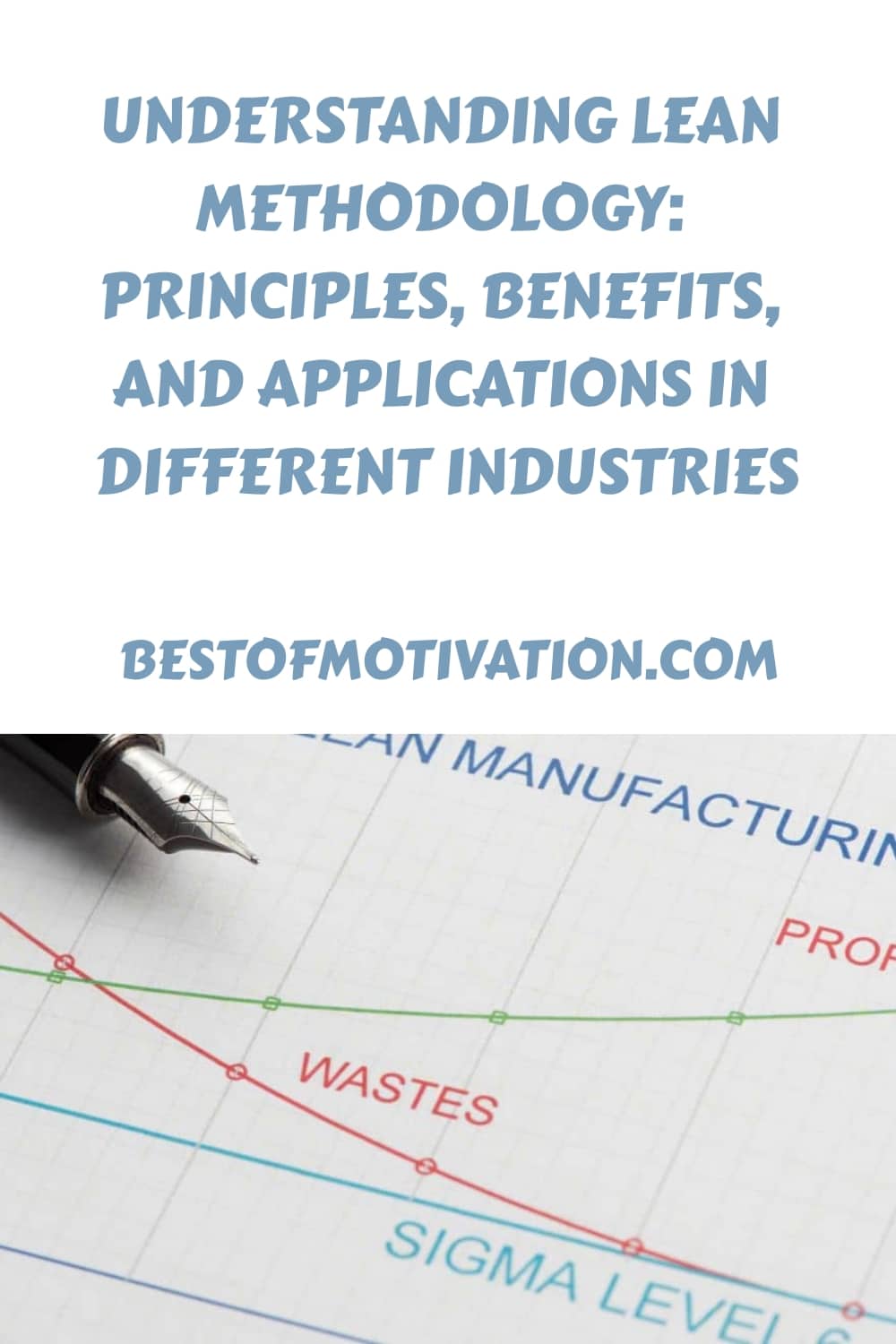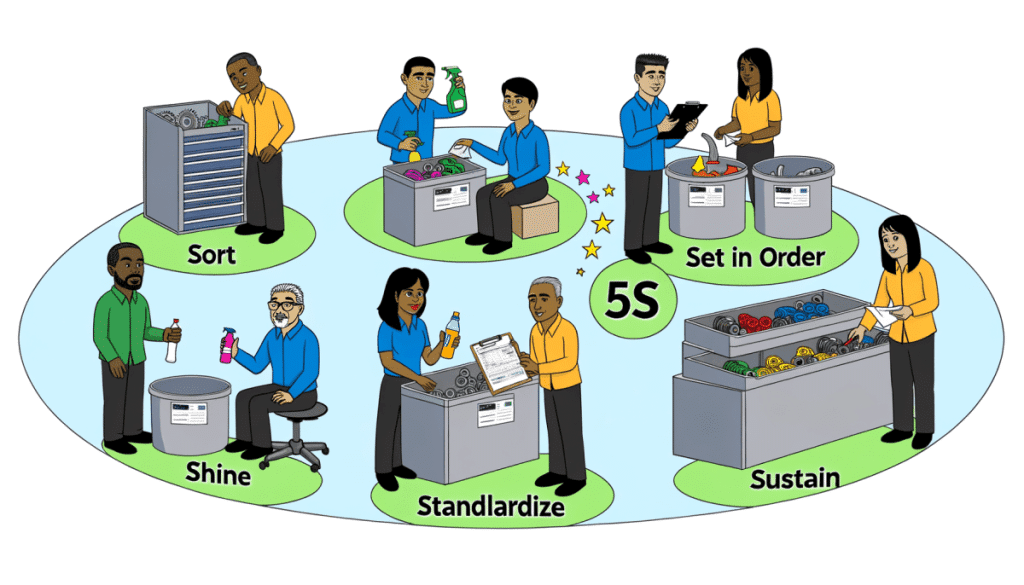Image Source: FreeImages
Welcome to the world of Lean Methodology, where efficiency and continuous improvement take center stage. In today’s fast-paced and competitive business landscape, organizations are constantly striving to streamline their processes, eliminate waste, and deliver exceptional value to their customers. And that’s where Lean comes in.
What is the Lean methodology?
Lean Methodology, also known as Lean Thinking or Lean Manufacturing, is a systematic approach that focuses on creating more value for customers with fewer resources. It originated in the manufacturing sector, specifically from Toyota’s Production System, and has since been adopted by various industries worldwide.
At its core, Lean is about identifying and eliminating non-value-added activities, also known as waste, in order to optimize resources and maximize productivity. It involves a shift in mindset towards continuous improvement, where every employee is encouraged to identify areas for improvement and contribute to making processes more efficient.
Principles of the Lean methodology
The Lean methodology is guided by a set of principles that serve as the foundation for its implementation. These principles include:
1. Value
The first principle of Lean is to define value from the customer’s perspective. This involves understanding what customers truly value and aligning processes to deliver that value.
2. Value Stream
The second principle focuses on identifying and mapping the value stream, which is the sequence of activities required to deliver a product or service. This helps to visualize the entire process and identify areas of waste or inefficiency.
3. Flow
The third principle emphasizes the importance of creating a smooth flow of work by eliminating bottlenecks and interruptions. By optimizing the flow, organizations can reduce lead times, improve customer satisfaction, and increase overall efficiency.
4. Pull
The fourth principle involves implementing a pull system, where work is initiated based on customer demand. This helps to prevent overproduction and reduces the risk of excess inventory.
5. Perfection
The final principle of Lean is continuous improvement. Organizations are encouraged to constantly strive for perfection by seeking ways to eliminate waste, improve processes, and enhance overall performance.
Benefits of adopting the Lean methodology
By adopting Lean methodology, organizations can experience a wide range of benefits. These include:
1. Increased Efficiency
Lean methodology helps organizations eliminate waste and streamline processes, resulting in increased efficiency and productivity. By focusing on value-added activities, organizations can optimize their use of resources and reduce unnecessary costs.
2. Improved Quality
Lean methodology places a strong emphasis on quality control and continuous improvement. By identifying and resolving issues as they arise, organizations can improve the quality of their products or services, leading to higher customer satisfaction and loyalty.
3. Enhanced Customer Value
Lean methodology encourages organizations to understand and deliver what customers truly value. By aligning processes with customer needs, organizations can provide a better customer experience and increase customer loyalty.
4. Increased Employee Engagement
Lean methodology empowers employees at all levels to contribute to process improvement. By involving employees in problem-solving and decision-making, organizations can increase employee engagement and create a culture of continuous learning and improvement.
5. Cost Savings
By eliminating waste and optimizing processes, organizations can reduce costs and increase profitability. Lean methodology helps identify areas of excess inventory, overproduction, and unnecessary activities, allowing organizations to focus on value-added activities and reduce unnecessary expenses.
Lean methodology in different industries
While Lean methodology originated in the manufacturing sector, its principles and approaches have been successfully applied to various industries. Here are a few examples:
1. Healthcare
In the healthcare industry, Lean methodology has been used to improve patient flow, reduce waiting times, and enhance overall efficiency. By eliminating waste and optimizing processes, hospitals and healthcare facilities can provide better care and improve patient satisfaction.
2. Software Development
Lean methodology has also found its way into software development. By applying Lean principles such as value stream mapping and continuous improvement, software development teams can deliver high-quality products more efficiently, reduce development cycles, and increase customer satisfaction.
3. Marketing
Even in the world of marketing, Lean methodology can be applied to optimize processes and improve campaign performance. By analyzing data, identifying wasteful activities, and focusing on value-added tasks, marketers can create more effective campaigns and achieve better results.
Lean tools and techniques
To implement Lean methodology effectively, organizations can utilize a range of tools and techniques. Some commonly used ones include:
1. Value Stream Mapping (VSM)
Value Stream Mapping is a visual tool used to analyze and map out the entire value stream of a process. It helps identify areas of waste, bottlenecks, and opportunities for improvement.
2. 5S
5S is a workplace organization method that focuses on creating and maintaining a clean, organized, and efficient work environment. The five S’s stand for Sort, Set in Order, Shine, Standardize, and Sustain.
3. Kanban
Kanban is a visual management tool that helps organizations manage their workflow. It involves the use of cards or boards to visualize tasks, track progress, and ensure a smooth flow of work.
4. Kaizen
Kaizen, which means continuous improvement in Japanese, is a philosophy that encourages small, incremental changes over time. It involves regularly reviewing processes, identifying areas for improvement, and implementing changes to achieve better results.
Implementing Lean in your organization
Implementing Lean methodology requires a systematic and structured approach. Here are some practical tips to get started:
1. Gain Leadership Support
Obtaining support from top-level management is crucial for successful implementation. Leaders need to understand the benefits of Lean and be actively involved in promoting and driving the initiative.
2. Educate and Train Employees
Provide training and education to employees at all levels to ensure they understand the principles and tools of Lean methodology. This will empower them to identify areas for improvement and actively participate in Lean initiatives.
3. Start Small
Implementing Lean methodology across the entire organization at once can be overwhelming. Start with a small pilot project or a specific department and gradually expand to other areas.
4. Involve Employees
Engage employees in the Lean implementation process by encouraging their input and involvement. This will help create a culture of continuous improvement and foster employee buy-in.
5. Measure and Track Progress
Establish key performance indicators (KPIs) to measure the impact of Lean initiatives. Regularly track and analyze data to identify areas of improvement and ensure progress is being made.
Common challenges in implementing Lean
Implementing Lean methodology can come with its fair share of challenges. Some common ones include:
1. Resistance to Change
Resistance to change is a common challenge when implementing Lean. Employees may be resistant to new processes or fear their roles may be impacted. Effective change management strategies and clear communication are essential to address this challenge.
2. Lack of Leadership Support
Without strong leadership support, Lean initiatives may struggle to gain traction. Leaders need to actively promote and champion Lean methodology to ensure its successful implementation.
3. Lack of Employee Engagement
Engaging employees and obtaining their buy-in is crucial for successful Lean implementation. Lack of employee engagement can hinder progress and limit the effectiveness of Lean initiatives.
4. Failure to Sustain Changes
Sustaining changes over the long term can be a challenge. Without ongoing monitoring and reinforcement, organizations may revert to old habits and lose the benefits of Lean methodology.
Case studies of successful Lean implementations
Many organizations have successfully implemented Lean methodology and achieved significant improvements. Here are a few case studies:
1. Toyota
Toyota is often cited as a prime example of successful Lean implementation. Through its Toyota Production System, the company has achieved high levels of efficiency, quality, and customer satisfaction.
2. Virginia Mason Medical Center
Virginia Mason Medical Center in the United States implemented Lean methodology to improve patient safety and reduce waste. The initiative resulted in shorter wait times, reduced costs, and improved patient outcomes.
3. Amazon
Amazon has embraced Lean principles in its operations, focusing on eliminating waste and optimizing its supply chain. The company’s commitment to continuous improvement has helped it become one of the most successful e-commerce companies in the world.
Lean training and certification programs
To gain a deeper understanding of Lean methodology and enhance your skills, there are various training and certification programs available. These programs provide comprehensive knowledge and practical tools to effectively implement Lean in your organization. Some popular Lean certifications include:
1. Lean Six Sigma
Lean Six Sigma combines Lean methodology with Six Sigma principles, focusing on process improvement and reducing variation. It is widely recognized and applicable across industries.
2. Lean Practitioner
Lean Practitioner certifications provide a solid foundation in Lean methodology and tools. These programs equip individuals with the knowledge and skills to drive Lean initiatives within their organizations.
3. Lean Sensei
Lean Sensei certifications are designed for individuals who have already gained experience in Lean implementation. These programs provide advanced training and mentorship to further develop expertise in Lean methodology.
Conclusion
Lean Methodology is a powerful approach that can revolutionize businesses across industries. By focusing on efficiency, continuous improvement, and delivering value to customers, organizations can create a leaner and more agile operation. Implementing Lean methodology may come with challenges, but the benefits are worth the effort. So embrace the Lean mindset, empower your employees, and unlock the full potential of your organization with Lean Methodology.
Remember, lean is not just a cost-cutting tool or a process optimization technique. It is a way of thinking and a cultural shift that fosters innovation, drives employee engagement, and ultimately leads to organizational success. So take the leap and embark on your Lean journey today!











